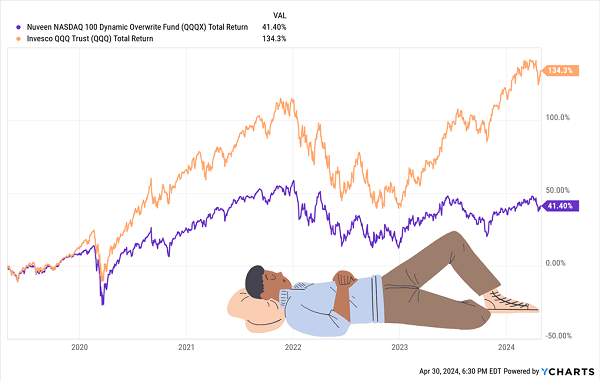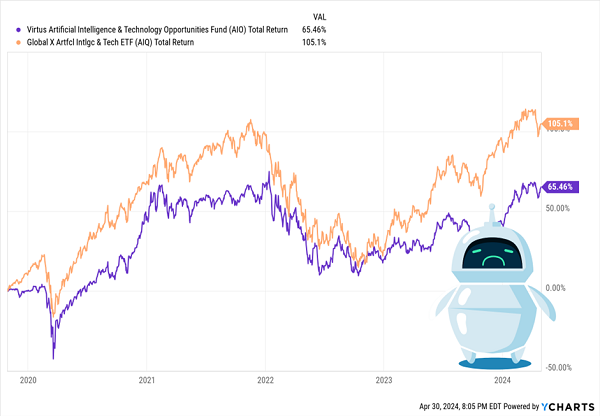Stock market rallies climb walls of worry. Well, we have no shortage of such worries today!
A few days ago, Bloomberg lamented there was “no relief in sight for bonds”. This was ironic because relief—the catalyst for the next big bond rally—is hidden in plain sight. Despite the despair, 10-year Treasury rates are still a ways off from their recent 5% highs last October:
Reality Check: Rates Still Lower Than Last Year

If they put in a “lower high”—as I’m expecting they will, thanks to a slowing economy and labor market—it will be wildly bullish for bonds (which trade inverse rates.) As well as their proxies, like tech stocks.
Wait, what?! Tech stocks?
That’s right. Following along our “bonds will be fine” thread, Nasdaq-related dividends are compelling in the short term. The “QQQs” tend to trade opposite the long rate, just like bonds.
Now I’m not a fan of buying the QQQs and hoping they go up. I prefer to create income securely and systematically—by buying funds that sell (“write”) covered calls on their tech holdings.
Volatility is high today thanks to the return of fear in the markets. This means option premiums are high, which means more income for the funds we are going to discuss.
All are closed-end funds (CEFs), which boast advantages over their larger mutual fund and ETF cousins. CEFs can use leverage to sell options (and generate yield), and their shares often disconnect from their underlying net asset values (NAVs).
The result? Discounts. And look at these deals, discounts up to 17% with yields averaging 7.8%.
Nuveen Nasdaq 100 Dynamic Overwrite Fund (QQQX)
Distribution Rate: 7.3%
Let’s start with the Nuveen Nasdaq 100 Dynamic Overwrite Fund (QQQX), which is like buying the QQQs—the Invesco QQQ ETF (QQQ)—with a pretty big twist.
While some investors trade covered calls on stocks to generate income, QQQX does it for us. It starts by purchasing stocks from the tech-heavy Nasdaq 100. Top holdings are exactly what we’d expect: Microsoft (MSFT), Apple (AAPL), Nvidia, Amazon, Meta … all the tech biggies. Then it sells covered calls on 35% to 75% of the notional value of the fund’s equity portfolio.
The pros? This strategy allows QQQX to throw off regular and fairly even distributions yielding a high 7%-plus right now, all while enjoying some of the price upside of these blue-chip tech stocks. The con? Covered calls can weigh on returns over the long haul because the fund’s best performers rise to the option-selling price and get sold, or “called away.”
The Result? Calmer (But Not Necessarily Higher) Returns

To its credit, QQQX at least executes this strategy much more intelligently than comparable index ETFs, which have little flexibility and often are restricted to only using certain contracts. This makes the CEF a worthwhile play to consider during periods of high volatility.
Moreover, as a closed-end fund, QQQX can trade at a significant discount to its net asset value, which ETFs also can’t do. Over the past five years, the CEF has traded right around its NAV on average. Currently? It’s almost 11% cheaper than NAV.
BlackRock Science and Technology Term Trust (BSTZ)
Distribution Rate: 7.1%
The BlackRock Science and Technology Term Trust (BSTZ), as the name implies, will invest primarily in companies “selected and their rapid and sustainable growth potential from the development, advancement, and use of science and/or technology.”
This approach leads to an even more technology-focused portfolio, at about 80% weight in the tech sector versus QQQX’s 50%. Also noteworthy is that this is very much a global fund, with about 35% invested in about a dozen countries outside the U.S., including the U.K., Taiwan and the Netherlands.
Like with QQQX, BSTZ also utilizes covered calls to generate income from its decidedly income-unfriendly holdings. But where BlackRock’s fund really stands out is in its ability to grant us exposure to private holdings we otherwise couldn’t touch.
In the top 10 holdings, we get some publicly traded companies like Nvidia and Synopsys (SNPS). But we also get cryptic terms like “Project Debussy” and “Project Picasso.” These refer to BlackRock’s respective private holdings in Databricks, a global data and AI company, and PsiQuantum, which aims to “build the first commercially useful quantum computer.”
BSTZ’s performance has admittedly been uneven since inception in June 2019. But its 2020-22 surge—which outpaced not just QQQX, but the QQQ itself—is proof that management has been able to catch lightning in a bottle at least once.
BlackRock Has Done It Before …

Something to keep in mind: BSTZ is a “term” trust. On or around June 26, 2031, the fund will dissolve and liquidate at net asset value. Because of that, this CEF likely will trade closer to its NAV as the term date nears. So the current 17% discount to NAV is something that, over the next seven years, should work in shareholders’ favor. A 7%-plus monthly distribution would help tide buyers over until then.
Virtus Artificial Intelligence & Technology Opportunities Fund
Distribution Rate: 9.2%
Virtus Artificial Intelligence & Technology Opportunities Fund (AIO) doesn’t come right out and say it, but it’s another term trust—this one expiring on or around Oct. 29, 2031—that could benefit from its discount (currently 7%) over time.
While there is no shortage of ways to get paid by artificial intelligence (AI), Virtus’ product is the purest CEF play. The fund will invest both directly in artificial intelligence companies, as well as in “other companies that stand to benefit from artificial intelligence and other technology opportunities.”
So, why is it lagging the ETF competition—and will it continue?
AIO Clearly Rides AI Momentum, But Something’s Holding It Back

Part of it is that aforementioned discount—the fund simply isn’t trading at the value of its assets.
But also, this isn’t a straight-up long-stock portfolio.
AIO doesn’t use options trades, but it does invest in debt to generate income. Only about half of AIO’s portfolio is made up of common stock. Some of those stocks are the usual AI suspects like Nvidia and Microsoft. But it also holds unexpected potential AI “beneficiaries” like Eli Lilly (LLY) and Hilton (HLT).
The rest of the portfolio? Well, 35% is in convertible securities, and the remaining 15% is in junk debt.
Management amplifies this portfolio by using debt leverage (about 15% currently). That means for every dollar in assets AIO holds, it can invest $1.15 into its highest-conviction ideas.
A Growing 12% Dividend? That’s Exactly What You Get With This Top Pick
Virtus’ fund is an interesting CEF, at the very least, that takes AI and turns it into a tool for generating income.
But I say, if you’re going to do something, don’t stop halfway.
If you want to invest in the growth of AI, don’t buy a fund that cuts it with bonds.
And if you want the big income of bonds, then really go big—with my top pick among a litter of incredible income plays right now.
This off-the-radar fund throws off a life-changing 12% current yield. Plus, it pays dividends monthly, grows its payout and boasts a history of special dividends, too!
A “Once-in-a-Generation” 12% Dividend Opportunity

Source: CEF Connect
When it comes to taking care of shareholders, this fund is unequaled. I’ve simply never seen an investment that puts dividends so far up its priority list.
These payouts are safe, too—delivered by a manager whom Morningstar previously named Fixed Income Manager of the Year. He’s also been inducted into the Fixed Income Analysts Society Hall of Fame.
To say he knows the bond world is an understatement—and now we can get him working for us, just in time to help us navigate the shifting winds we’ll no doubt encounter in the year ahead.
Don’t miss this opportunity, which I’m urging ALL investors to take advantage of now. Click here to learn more about this 12%-yielding income play and get a free Special Report revealing my latest research on it.
Before you make your next trade, you'll want to hear this.
MarketBeat keeps track of Wall Street's top-rated and best performing research analysts and the stocks they recommend to their clients on a daily basis.
Our team has identified the five stocks that top analysts are quietly whispering to their clients to buy now before the broader market catches on... and none of the big name stocks were on the list.
They believe these five stocks are the five best companies for investors to buy now...
See The Five Stocks Here
Unlock the timeless value of gold with our exclusive 2025 Gold Forecasting Report. Explore why gold remains the ultimate investment for safeguarding wealth against inflation, economic shifts, and global uncertainties. Whether you're planning for future generations or seeking a reliable asset in turbulent times, this report is your essential guide to making informed decisions.
Get This Free Report